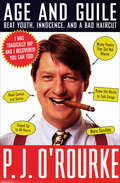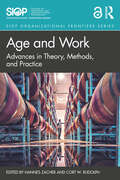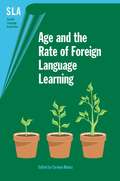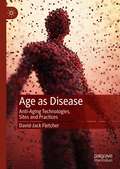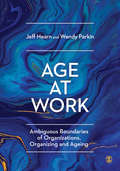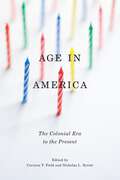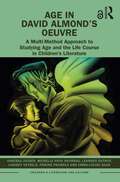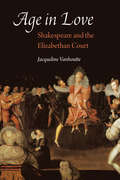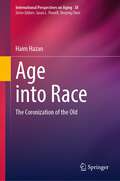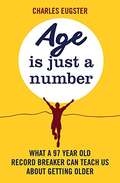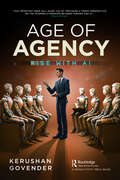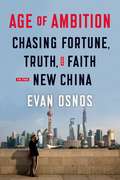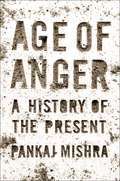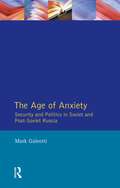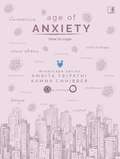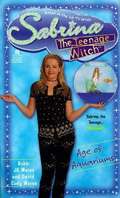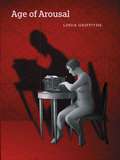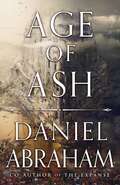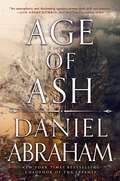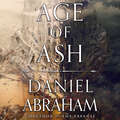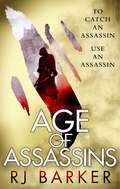- Table View
- List View
Age and Guile: Beat Youth, Innocence, and a Bad Haircut
by P. J. O'Rourke<p>Readers may be shocked to discover that America's most provocative (and conservative) satirist, P. J. O'Rourke, was at one time a raving pinko, with scars on his formerly bleeding heart to prove it. In Age and Guile Beat Youth, Innocence, and a Bad Haircut, O'Rourke chronicles the remarkable trajectory that took him from the lighthearted fun of the revolutionary barricades to the serious business of the nineteenth hole. How did the O'Rourke of 1970, who summarized the world of "grown-ups" as "materialism, sexual hang-ups, the Republican party, uncomfortable clothes, engagement rings, car accidents, Pat Boone, competition, patriotism, cheating, lying, ranch houses, and TV" come to be in favor of all of those things? <p>What causes a beatnik-hippie type, comfortable sleeping on dirty mattresses in pot-addled communes—as P. J. did when he was a writer for assorted "underground" papers-to metamorphosize into a right-wing middle-aged grouch? Here, P. J. shows how his Socialist idealism and avant-garde aesthetic tendencies were cured and how he acquired a healthy and commendable interest in national defense, the balanced budget, Porsches, and Cohiba cigars. P. J. O'Rourke's message is that there's hope for all those suffering from acute Bohemianism, or as he puts it, "Pull your pants up, turn your hat around, and get a job."</p>
Age and Identity in Eighteenth-Century England ("The Body, Gender and Culture" #11)
by Helen YallopYallop looks at how people in eighteenth-century England understood and dealt with growing older. Though no word for ‘aging’ existed at this time, a person’s age was a significant aspect of their identity.
Age and Work: Advances in Theory, Methods, and Practice (SIOP Organizational Frontiers Series)
by Cort W. Rudolph Hannes ZacherThe edited volume Age and Work: Advances in Theory, Methods, and Practice presents a systematic collection of key advances in theory, methods, and practice regarding age(ing) and work. This cutting-edge collection breaks new ground by developing novel and useful theory, explaining underutilized but important methodological approaches, and suggesting original practical applications of emerging research topics. The book begins with a prologue by the World Health Organization’s unit head for aging and health, an introduction on the topic by the editors, and an overview of past, current, and future workforce age trends. Subsequently, the first main section outlines theoretical advances regarding alternative age constructs (e.g., subjective age), intersectionality of age with gender and social class, paradoxical age-related actions, generational identity, and integration of lifespan theories. The second section presents methodological advances regarding behavioral assessment, age at the team and organizational levels, longitudinal and diary methods, experiments and interventions, qualitative methods, and the use of archival data. The third section covers practical advances regarding age and job crafting, knowledge exchange, the work/nonwork interface, healthy aging, and absenteeism and presenteeism, and organizational meta-strategies for younger and older workers. The book concludes with an epilogue by an eminent scholar in age and work. Written in a scientific yet accessible manner, the book offers a valuable resource for undergraduate and graduate students, academics in the fields of psychology and business, as well as practitioners working in the areas of human resource management and organizational development.
Age and the Rate of Foreign Language Learning
by Carmen MunozThis book examines the various ways in which age affects the process and the product of foreign language learning in a school setting. It presents studies that cover a wide range of topics, from phonetics to learning strategies. It will be of interest to students and researchers working in SLA research, language planning and language teaching.
Age and the Reach of Sociological Imagination: Power, Ideology and the Life Course (Aging and Society)
by Dale DanneferThe dominant narratives of both science and popular culture typically define aging and human development as self-contained individual matters, failing to recognize the degree to which they are shaped by experiential and contextual contingencies. Our understandings of age are thereby "boxed in" and constricted by assumptions of "normality" and naturalness that limit our capacities to explore possible alternative experiences of development and aging, and the conditions – both individual and social – that might foster such experiences. Combining foundational principles of critical social science with recent breakthroughs in research across disciplines ranging from biology to economics, this book offers a scientifically and humanly expanded landscape for apprehending the life course. Rejecting familiar but false dichotomies such as "nature vs. nurture" and "structure vs. agency", it clarifies the organismic fundamentals that make the actual content of experience so centrally important in age and development, and it also explores why attention to these fundamentals has been so resisted in studies of individuals and individual change, and in policy and practice as well. In presenting the basic principles and reviewing the current state of knowledge, Dale Dannefer introduces multi-levelled social processes that shape human development and aging over the life course and age as a cultural phenomenon – organizing his approach around three key frontiers of inquiry that each invite a vigorous exercise of sociological imagination: the Social-Structural Frontier, the Biosocial Frontier and the Critical-Reflexive Frontier.
Age as Disease: Anti-Aging Technologies, Sites and Practices
by David-Jack FletcherAge as Disease explores the foundations of gerontology as a discipline to examine the ways contemporary society constructs old age as a disease-state. Framed throughout as ‘gerontological hygeine’, this book examines contemporary regimes, strategies and treatment protocols deployed throughout Australia, the United States, and the United Kingdom. The book deploys critical cultural theories such as biopolitics, somatechnics, ethics, and governmentality to examine how anti-aging technologies operate to problematise the aging body as always-already diseased, and how these come to constitute a movement of abolition, named here as ‘gerontological hygiene’.
Age at Work: Ambiguous Boundaries of Organizations, Organizing and Ageing
by Jeff Hearn Wendy ParkinAge at Work explores the myriad ways in which ‘age’ is at ‘work’ across society, organizations and workplaces, with special focus on organizations, their boundaries, and marginalizing processes around age and ageism in and across these spaces. The book examines: how society operates in and through age, and how this informs the very existence of organizations; age-organization regimes, age-organization boundaries, and the relationship between organizations and death, and post-death the importance of memory, forgetting and rememorizing in re-thinking the authors’ and others’ earlier work tensions between seeing age in terms of later life and seeing age as pervasive social relations. Enriched with insights from the authors’ lived experiences, Age at Work is a major and timely intervention in studies of age, work, care and organizations. Ideal for students of Sociology, Organizations and Management, Social Policy, Gerontology, Health and Social Care, and Social Work.
Age at Work: Ambiguous Boundaries of Organizations, Organizing and Ageing
by Jeff Hearn Wendy ParkinAge at Work explores the myriad ways in which ‘age’ is at ‘work’ across society, organizations and workplaces, with special focus on organizations, their boundaries, and marginalizing processes around age and ageism in and across these spaces. The book examines: how society operates in and through age, and how this informs the very existence of organizations; age-organization regimes, age-organization boundaries, and the relationship between organizations and death, and post-death the importance of memory, forgetting and rememorizing in re-thinking the authors’ and others’ earlier work tensions between seeing age in terms of later life and seeing age as pervasive social relations. Enriched with insights from the authors’ lived experiences, Age at Work is a major and timely intervention in studies of age, work, care and organizations. Ideal for students of Sociology, Organizations and Management, Social Policy, Gerontology, Health and Social Care, and Social Work.
Age in America: The Colonial Era to the Present (Gender And American Culture Ser.)
by Nicholas L. Syrett Corinne T. FieldEighteen. Twenty-one. Sixty-five. In America today, we recognize these numbers as key transitions in our lives—precise moments when our rights and opportunities change—when we become eligible to cast a vote, buy a drink, or enroll in Medicare. This volume brings together scholars of childhood, adulthood, and old age to explore how and why particular ages have come to define the rights and obligations of American citizens. Since the founding of the nation, Americans have relied on chronological age to determine matters as diverse as who can marry, work, be enslaved, drive a car, or qualify for a pension. Contributors to this volume explore what meanings people in the past ascribed to specific ages and whether or not earlier Americans believed the same things about particular ages as we do. The means by which Americans imposed chronological boundaries upon the variable process of growing up and growing old offers a paradigmatic example of how people construct cultural meaning and social hierarchy from embodied experience. Further, chronological age always intersects with other socially constructed categories such as gender, race, and sexuality. Ranging from the seventeenth century to the present, taking up a variety of distinct subcultures—from frontier children and antebellum slaves to twentieth-century Latinas—Age in America makes a powerful case that age has always been a key index of citizenship.
Age in David Almond’s Oeuvre: A Multi-Method Approach to Studying Age and the Life Course in Children’s Literature (Children's Literature and Culture)
by Vanessa Joosen Michelle Anya Anjirbag Leander Duthoy Lindsey Geybels Frauke Pauwels Emma-Louise SilvaIn recent decades, age studies has started to emerge as a new approach to study children’s literature. This book builds on that scholarship but also significantly extends it by exploring age in various aspects of children’s literature: the age of the author, the characters, the writing style, the intended readership and the real reader. Moreover, the authors explore what different theories and methods can be used to study age in children’s literature, and what their affordances and limits are. The analyses combine age studies with life writing studies, cognitive narratology, digital humanities, comparative literary studies, reader-response research and media studies. To ensure coherence, the book offers an in-depth exploration of the oeuvre of a single author, David Almond. The aesthetic and thematic richness of Almond’s works has been widely recognised. This book adds to the understanding of his oeuvre by offering a multi-faceted analysis of age. In addition to discussing the film adaptation of his best-known novel Skellig, this book also offers analyses of works that have received less attention, such as Counting Stars, Clay and Bone Music. Readers will also get a fuller understanding of Almond as a crosswriter of literature for children, adolescents and adults.
Age in Love: Shakespeare and the Elizabethan Court (Early Modern Cultural Studies)
by Jacqueline VanhoutteThe title Age in Love is taken from Shakespeare’s sonnet 138, a poem about an aging male speaker who, by virtue of his entanglement with the dark lady, “vainly” performs the role of “some untutor’d youth.” Jacqueline Vanhoutte argues that this pattern of “age in love” pervades Shakespeare’s mature works, informing his experiments in all the dramatic genres. Bottom, Malvolio, Claudius, Falstaff, and Antony all share with the sonnet speaker a tendency to flout generational decorum by assuming the role of the lover, normally reserved in Renaissance culture for young men. Hybrids and upstarts, cross-dressers and shape-shifters, comic butts and tragic heroes—Shakespeare’s old-men-in-love turn in boundary-blurring performances that probe the gendered and generational categories by which early modern subjects conceived of identity. In Age in Love Vanhoutte shows that questions we have come to regard as quintessentially Shakespearean—about the limits of social mobility, the nature of political authority, the transformative powers of the theater, the vagaries of human memory, or the possibility of secular immortality—come to indelible expression through Shakespeare’s artful deployment of the “age in love” trope. Age in Love contributes to the ongoing debate about the emergence of a Tudor public sphere, building on the current interest in premodern constructions of aging and ultimately demonstrating that the Elizabethan court shaped Shakespeare’s plays in unexpected and previously undocumented ways.
Age into Race: The Coronization of the Old (International Perspectives on Aging #38)
by Haim HazanAge into Race is a socio-anthropological essay on the repercussions of the Covid-19 pandemic on the cultural status of the old. As the worldwide horrors of the Corona era have since been publicly repressed, the text is geared to revisit and relive the tenor of that time while considering its latent revolutionary aftermath. There was wide agreement that Covid-19 policies targeted older people as a risk group in need of protection, setting it apart from the rest of society. Yet, paradoxically, long-term facilities for older people effectively became Covid-19 death traps. What kind of abandonment propelled this apparent contradiction? This book provides an answer by looking at ageist practices regarding Covid-19 triaging, lockdowns and distancing that affected older people around the world, devising Covid-19 as an inevitable "problem of the elderly" and, by implication, instating and categorizing "the elderly" as a public problem to be bio-politically managed and wrought. The Covid-19 pandemic and its concomitant "state of emergency" triggered an accelerated transmutation of customary ageism into emergent racism, spelling a fatal switch to designating the old as bearers of "bare" life unworthy of human living, thus turning old age from a seemingly cultural category to a socially fabricated viral menace of nature. The book tracks down the process through which the "Coronization" of culture legitimized and impelled a further stigmatization of old age beyond mere ageism to sheer racism. Thus, this transmutation, while compromising their autonomy and subjectivity via imposed lockdowns, social isolation, excommunication and selective discrimination rendered the old a race apart. Subsequently, the moral panic invoked by the specter of the pandemic transformed the social perceptions of later life from a containable social problem to an unbridled public hazard that summoned total measures presented as bureaucratically regimented regulations that dehumanized its victims with impunity.
Age is Just a Number: What a 97 year old record breaker can teach us about growing older
by Charles EugsterRetired dental surgeon Charles Eugster rekindled a love of competitive rowing he'd neglected for most of his adult life at the age of 63. He took up bodybuilding at the age of 87. And at the age of 95 he started sprinting for the first time in his life, becoming World Champion at 200m indoor and 400m outdoor. He is a world record holder for his age group in a number of sports, and has 40 Gold Medals for World Masters Rowing. In this book, Charles shares his journey and his passionate belief that growing older needn't slow you down. And he shows his readers how taking on new challenges, learning new things, and improving your body as it ages is not only fun, but rewarding for the individual, and beneficial to society.
Age is Just a Number: What a 97 year old record breaker can teach us about growing older
by Charles EugsterRetired dental surgeon Charles Eugster rekindled a love of competitive rowing he'd neglected for most of his adult life at the age of 63. He took up bodybuilding at the age of 87. And at the age of 95 he started sprinting for the first time in his life, becoming World Champion at 200m indoor and 400m outdoor. He is a world record holder for his age group in a number of sports, and has 40 Gold Medals for World Masters Rowing. In this book, Charles shares his journey and his passionate belief that growing older needn't slow you down. And he shows his readers how taking on new challenges, learning new things, and improving your body as it ages is not only fun, but rewarding for the individual, and beneficial to society.
Age of Agency: Rise with AI
by Kerushan Govender"When the digital world started, many companies moved slowly and cautiously, not willing to replace their traditional operations. Now most companies have gone digital. We are now moving beyond digital into an AI world. Don't ignore it. This important book will guide you by providing a fresh perspective on the interrelationships between humans and AI." – Philip Kotler Do you feel overwhelmed by the AI wave? Worried that it could cost you your job, harm your business, or even take over? AI has pervaded our lives and is aggressively disrupting business. No person today can afford to ignore AI. Age of Agency is your companion, helping you leverage AI's capabilities to power your productivity and success. By understanding AI, you will learn to use it as a tool for personal career growth and business success. Former Microsoft executive Kerushan Govender demystifies AI, emphasising the importance of human agency. Reconnect with the needs of humanity and learn the importance of care as a differentiator in an AI world. Avoid the potential pitfalls of excessive reliance on the technology. Age of Agency is a blueprint for ensuring human agency outpaces computer agency. It boldly pits the limits of machine learning against the infinity of human ability. With this survival guide, you’ll uncover ways to connect with humanity on a deeper level, going beyond anything AI can do. Ready to become AI-savvy, with your humanity as your differentiator? Dive into the future with the confidence to ride the wave of today’s AI revolution.
Age of Ambition: Chasing Fortune, Truth, and Faith in the New China
by Evan OsnosWinner of the 2014 National Book Award in nonfiction. An Economist Best Book of 2014. A vibrant, colorful, and revelatory inner history of China during a moment of profound transformation From abroad, we often see China as a caricature: a nation of pragmatic plutocrats and ruthlessly dedicated students destined to rule the global economy-or an addled Goliath, riddled with corruption and on the edge of stagnation. What we don't see is how both powerful and ordinary people are remaking their lives as their country dramatically changes  As the Beijing correspondent for The New Yorker, Evan Osnos was on the ground in China for years, witness to profound political, economic, and cultural upheaval. In Age of Ambition, he describes the greatest collision taking place in that country: the clash between the rise of the individual and the Communist Party's struggle to retain control. He asks probing questions: Why does a government with more success lifting people from poverty than any civilization in history choose to put strict restraints on freedom of expression? Why do millions of young Chinese professionals-fluent in English and devoted to Western pop culture-consider themselves "angry youth," dedicated to resisting the West's influence? How are Chinese from all strata finding meaning after two decades of the relentless pursuit of wealth? Writing with great narrative verve and a keen sense of irony, Osnos follows the moving stories of everyday people and reveals life in the new China to be a battleground between aspiration and authoritarianism, in which only one can prevail.
Age of Anger: A History of the Present
by Pankaj MishraOne of our most important public intellectuals reveals the hidden history of our current global crisisHow can we explain the origins of the great wave of paranoid hatreds that seem inescapable in our close-knit world—from American shooters and ISIS to Donald Trump, from a rise in vengeful nationalism across the world to racism and misogyny on social media? In Age of Anger, Pankaj Mishra answers our bewilderment by casting his gaze back to the eighteenth century before leading us to the present.He shows that as the world became modern, those who were unable to enjoy its promises—of freedom, stability, and prosperity—were increasingly susceptible to demagogues. The many who came late to this new world—or were left, or pushed, behind—reacted in horrifyingly similar ways: with intense hatred of invented enemies, attempts to re-create an imaginary golden age, and self-empowerment through spectacular violence. It was from among the ranks of the disaffected that the militants of the nineteenth century arose—angry young men who became cultural nationalists in Germany, messianic revolutionaries in Russia, bellicose chauvinists in Italy, and anarchist terrorists internationally.Today, just as then, the wide embrace of mass politics and technology and the pursuit of wealth and individualism have cast many more billions adrift in a demoralized world, uprooted from tradition but still far from modernity—with the same terrible results.Making startling connections and comparisons, Age of Anger is a book of immense urgency and profound argument. It is a history of our present predicament unlike any other.
Age of Anxiety, The: Security and Politics in Soviet and Post-Soviet Russia
by Mark GaleottiThe geography of Russia -- vast, unwieldy, exposed -- and her tragic history of foreign invasion have created an overriding sense of military vulnerability amongst her leaders that, after the horrors of the Second World War, amounted almost to paranoia. This important study of the years since Brezhnev shows how this obsession with national security have been at the core of Russian thinking right through the reforms of the Gorbachev era and the eventual collapse of the USSR, and continues to dominate the turbulent politics of post-Soviet Russia today.
Age of Anxiety: How to Cope
by Amrita Tripathi Kamna Chhibber&‘What does it mean when someone says they have Anxiety?&’&‘I&’m stressed and nervous all the time, do I have Anxiety?&’&‘Will I ever get better?&’These are some of the questions we want to answer in this book. Is this the Age of Anxiety? Well, how could it not be – when so many millions of us feel that persistent combination of heart palpitations, impending doom, dread, even lack of control, as one of our contributors describes it. The question is, what can we do about it?Through this book we will learn how to distinguish between anxiety as 'an attack of the nerves' or something that will come and go, and Anxiety as a disorder, which will need treatment, including possibly therapy or medication. The conversations are even more pertinent given the global Covid-19 pandemic, prolonged periods of social isolation and an increased focus on mental health and wellness. We learn from coping with Anxiety Disorders, sharing their journey to healing, explaining exactly what would have helped them along the way, as they seek to bust common myths and misconceptions.
Age of Aquariums (Sabrina the Teenage Witch #20)
by Bobbi Weiss David WeissWhile cleaning up the school's new aquarium, Sabrina notices some rather unusual underwater inhabitants. Transforming herself into a tiny mermaid, she discovers the lost city of Atlantis...inside the fish tank! The great shrunken city is home to a mer-race so old it doesn't even remember its own origins. But the Atlanteans are sure that Sabrina is one of the legendary Conch Queens, come to take the city back to the Endless Waters. Sabrina wants to restore the city to its rightful place on the planet, but how can she do it without exposing her magic powers to Mr. Kraft and her mortal classmates? And what if someone doesn't want the lost city to be found?
Age of Arousal
by Linda GriffithsIt's a time of passion and confusion. Virtue is barely holding down its petticoats. People are bursting their corsets with unbridled desire. It's 1885, and the typewriter and the suffrage movement are sending things topsy-turvy. In the midst of it all, five ambitious New Women and one Newish Man struggle to find their way. Miss Mary Barfoot runs a school for secretaries with her young lover, Miss Rhoda Nunn. But when the Misses Madden spinsters Virginia and Alice and beautiful young Monica arrive, along with the attractive Dr. Everard Barfoot, things can never be the same.Age of Arousal is a lavish, sexy, frenetic ensemble piece about the forbidden and gloriously liberated self genre-busting, rule-bending, and ambitiously original. The book includes notes and a rousing, thoughtful essay on Victorian womens' suffrage by the playwright.'Endlessly witty, vigorous, funny... brilliantly inventive.' - Calgary Herald 'Griffiths is one of Canada's 'originals' known not only for the quality of her work, but for the sheer range of her career.' - Maclean's
Age of Ash
by Daniel Abraham'ATMOSPHERIC AND FASCINATING' Joe Abercrombie'SPECTACULAR' Django Wexler'OUTSTANDING' Publishers WeeklyFrom New York Times bestselling and critically acclaimed author Daniel Abraham, co-author of the Expanse, comes a monumental epic fantasy trilogy that unfolds within the walls of a single great city, over the course of one tumultuous year, where every story matters, and the fate of the city is woven from them all.Kithamar is a centre of trade and wealth, an ancient city with a long, bloody history where countless thousands live and their stories unfold. This is Alys's.When her brother is murdered, a petty thief from the slums of Longhill sets out to discover who killed him and why. But the more she discovers about him, the more she learns about herself, and the truths she finds are more dangerous than knives. Swept up in an intrigue as deep as the roots of Kithamar, where the secrets of the lowest born can sometimes topple thrones, the story Alys chooses will have the power to change everything.Praise for Daniel Abraham:'EVERYTHING I LOOK FOR IN A FANTASY' George R. R. Martin'A RICH, SATISFYINGLY COMPLEX EPIC FANTASY' Publishers Weekly'PREPARE TO BE SHOCKED, STARTLED AND ENTERTAINED' Locus
Age of Ash (The Kithamar Trilogy #1)
by Daniel AbrahamFrom Hugo award-winning, and New York Times bestselling co-author of the Expanse, Daniel Abraham, Age of Ash is the first book in an epic fantasy trilogy that unfolds within the walls of a single great city where every story matters —and the fate of the city is woven from them all.&“An atmospheric and fascinating tapestry, woven with skill and patience.&” – Joe Abercrombie, New York Times bestselling author of A Little Hatred Kithamar is a center of trade and wealth, an ancient city with a long, bloody history where countless thousands live and their stories unfold. This is Alys's. When her brother is murdered, a petty thief from the slums of Longhill sets out to discover who killed him and why. But the more she discovers about him, the more she learns about herself, and the truths she finds are more dangerous than knives. Swept up in an intrigue as deep as the roots of Kithamar, where the secrets of the lowest born can sometimes topple thrones, the story Alys chooses will have the power to change everything."An outstanding series debut, which instantly hooks readers with Paul mysteries . . . Readers will eagerly anticipate the sequel." – Publishers Weekly (starred review)For more from Daniel Abraham, check out: The Dagger and the CoinThe Dragon's Path The King's Blood The Tyrant's Law The Widow's House The Spider's War
Age of Ash: The Sunday Times bestseller - The Kithamar Trilogy Book 1 (The Kithamar Trilogy)
by Daniel Abraham***THE SUNDAY TIMES BESTSELLER***'ATMOSPHERIC AND FASCINATING' Joe Abercrombie'SPECTACULAR' Django WexlerFrom New York Times bestselling and critically acclaimed author Daniel Abraham, co-author of the Expanse, comes a monumental epic fantasy trilogy that unfolds within the walls of a single great city, over the course of one tumultuous year, where every story matters, and the fate of the city is woven from them all.Kithamar is a centre of trade and wealth, an ancient city with a long, bloody history where countless thousands live and their stories unfold. This is Alys's.When her brother is murdered, a petty thief from the slums of Longhill sets out to discover who killed him and why. But the more she discovers about him, the more she learns about herself, and the truths she finds are more dangerous than knives. Swept up in an intrigue as deep as the roots of Kithamar, where the secrets of the lowest born can sometimes topple thrones, the story Alys chooses will have the power to change everything.Praise for Daniel Abraham:'EVERYTHING I LOOK FOR IN A FANTASY' George R. R. Martin'A RICH, SATISFYINGLY COMPLEX EPIC FANTASY' Publishers Weekly'PREPARE TO BE SHOCKED, STARTLED AND ENTERTAINED' Locus
Age of Assassins (The Wounded Kingdom #1)
by Rj BarkerIT'S A GAME OF ASSASSIN VERSUS ASSASSINGirton Club-foot has no family, a crippled leg, and is apprenticed to the best assassin in the land. He's learning the art of taking lives, but his latest mission tasks him with a far more difficult challenge: to save a life. Someone is trying to kill the heir to the throne, and it is up to Girton to uncover the traitor and prevent the prince's murder. Age of Assassins is the first in an epic new trilogy set in a world ravaged by magic, featuring a cast of assassins, knights, ambitious noblemen, and fools.
